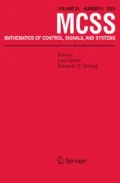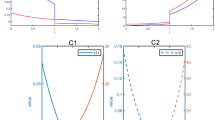Abstract
This paper shows that within the space of all LTI systems, equipped with the Zariski topology, the set of impulse controllable systems contains an open dense set of systems; in other words, impulse controllable systems are generic. This genericity persists for many closed subsets of LTI systems of interest, such as the class of singular descriptor systems.

Similar content being viewed by others
Notes
By shift invariance, the choice of \(t=1\) above is not important, any \(t \ne 0\) suffices. We use the value \(\left( X_M({\frac{\textsf {d} }{\textsf {dt} }}) f \right) _{t = 1}\) as an initial value of a potential solution f to \(M({\frac{\textsf {d} }{\textsf {dt} }})\), i.e. for \(\lim _{t \nearrow 0} f(t)\).
Indeed, the kernel of the operator \(M({\frac{\textsf {d} }{\textsf {dt} }}): ({\mathcal {D}}')^k \rightarrow ({\mathcal {D}}')^\ell \) is isomorphic to \({\textsf {Hom}}_A(A^k/M, ~{\mathcal {D}}')\), the module of homomorphisms from \(A^k/M\) to the space of distributions \({\mathcal {D}}'\), for instance [9].
We refer to any standard book on Algebra for definitions, for instance, D. Eisenbud: Commutative algebra with a view towards algebraic geometry.
References
Berger T, Reis T (2013) Controllability of linear differential-algebraic systems: a survey. In: Ilchmann A, Reis T (eds) Surveys in differential-algebraic equations I, Differential-algebraic equations forum. Springer, Berlin
Cobb D (1984) Controllability, observability, and duality in singular systems. IEEE Trans Autom Control 29:1076–1082
Dai L (1989) Singular systems. Springer, Berlin
Kalaimani RK, Praagman C, Belur MN (2016) Impulse controllability: from descriptor systems to higher order DAEs. IEEE Trans Autom Control 61(9):2463–2472
Lomadze V, Mahmood H (2010) Smooth/impulsive linear systems: axiomatic description. Linear Algebra Appl 433(11):1997–2009
Pugh AC, Antoniou EN, Karampetakis NP (2007) Equivalence of AR-representations in the light of the impulsive-smooth behaviour. J Robust Nonlinear Control 17:769–785
Rosenbrock HH (1974) Structural properties of linear dynamical systems. Int J Control 20:191–202
Rapisarda P, Willems JC (1997) State maps for linear systems. SIAM J Control Optim 35:1053–1091
Shankar S (2014) The Hautus test and genericity results for controllable and uncontrollable behaviors. SIAM J Control Optim 52:32–51
Shankar S (2018) Structurally stable properties of control systems, arXiv:1812.08992 [math.OC]
Vinjamoor H, Belur MN (2010) Impulse free interconnection of dynamical systems. Linear Algebra Appl 432:637–660
Verghese GC, Lévy BC, Kailath T (1981) A generalized state-space for singular systems. IEEE Trans Autom Control 26:811–831
Willems JC (2007) The behavioral approach to open and interconnected systems. IEEE Control Syst Mag 27:46–99
Acknowledgements
The second author thanks the Department of Electrical Engineering, IIT Bombay, for its hospitality during the time this paper was written.
Author information
Authors and Affiliations
Corresponding author
Additional information
Publisher's Note
Springer Nature remains neutral with regard to jurisdictional claims in published maps and institutional affiliations.
Rights and permissions
About this article
Cite this article
Belur, M.N., Shankar, S. The persistence of impulse controllability. Math. Control Signals Syst. 31, 487–501 (2019). https://doi.org/10.1007/s00498-019-00250-x
Received:
Accepted:
Published:
Issue Date:
DOI: https://doi.org/10.1007/s00498-019-00250-x




